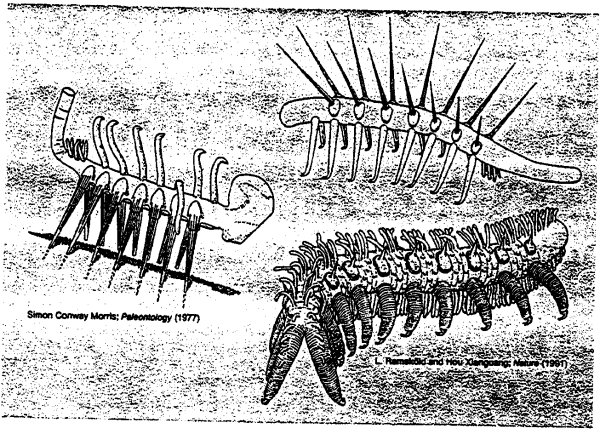
Left: Conway Morris's Original reconstruction of Hallucigenia, Right,
top and bottom; Ramskold and Hou's inversion of Hallucigenia as an onychophoran
and their reconstruction of the new Chengjiang onychophoran with side
plates and spines.
clearly bears interesting implications. This third way has been supported,
often by well-respected taxonomists, but our general preference for shoehorns
and straightening rods has given it short shrift. The Onychophora, under
this view, might represent a separate group, endowed with sufficient anatomical
uniqueness to constitute its own major division of the animal kingdom,
despite the low diversity of living representatives. After all, the criterion
for separate status should be degree of genealogical distinctness, not
current success as measured by number of species. A lineage may need a
certain minimal membership just to have enough raw material available
so that evolution can craft sufficient difference for high taxonomic rank.
But current diversity is no measure of available raw material through
geological history. Evolution is ebb and flow, waxing and waning; once
great groups can be reduced to a fraction of their past glory. A great
man once told us that the last shall be first, but just by the geometry
of evolution, and not by moral law, the first can also become last. Perhaps
the Onychophora were once a much more diverse group, standing wide and
tall in their distinctness, while Peripatus and its allies now
form a pitifully reduced remnant.
(By speaking of potential distinctness, I am not making any untenable--indeed
it would be nonsensical--claim for total separation without any relationship
to other phyla. Very few taxonomists doubt that onychophorans, along with
other potentially distinct groups known as tardigrades and pentastomes,
have their evolutionary linkages close to annelids and arthropods. But
this third view places onychophorans as a separate limb of life's tree--branching
off near the limbs of annelids and arthropods and eventually joining them
to form a major trunk--whereas the shoehorn would stuff onychophorans
into the Arthropoda, and the straightening rod would change life's geometry
from a tree to a line and place onychophorans between primitive worms
and more advanced insects.)
We can only test this third possibility by searching for onychophorans
in the fossil record--a daunting task because they have no preservable
hard parts and therefore do not usually fossilize. I write this essay
because several striking new discoveries and interpretations, all made
in the past year or two, now point to a markedly greater diversity for
onychophorans right at the beginning of modern multicellular life, following
the Cambrian explosion some 550 million years ago. These discoveries arise
from two fortunate and quite different circumstances: first, onychophorans
have been found in the rare soft-bodied faunas occasionally preserved
by happy geological accidents in the fossil record; second, some ancient
onychophorans possessed hard parts and can therefore appear in ordinary
fossil deposits.
I fully realize that this expansion in onychophoran diversity at the
beginning of multicellular animal life can scarcely rank as the hottest
news item of the year. Most readers of this column, after all, have probably
never heard the word onychophoran and, lamentably, have no acquaintance
with poor, lovely Peripatus. So why get excited about old onychophorans
if you never knew that modern ones existed in the first place? Do hear
me out
|
